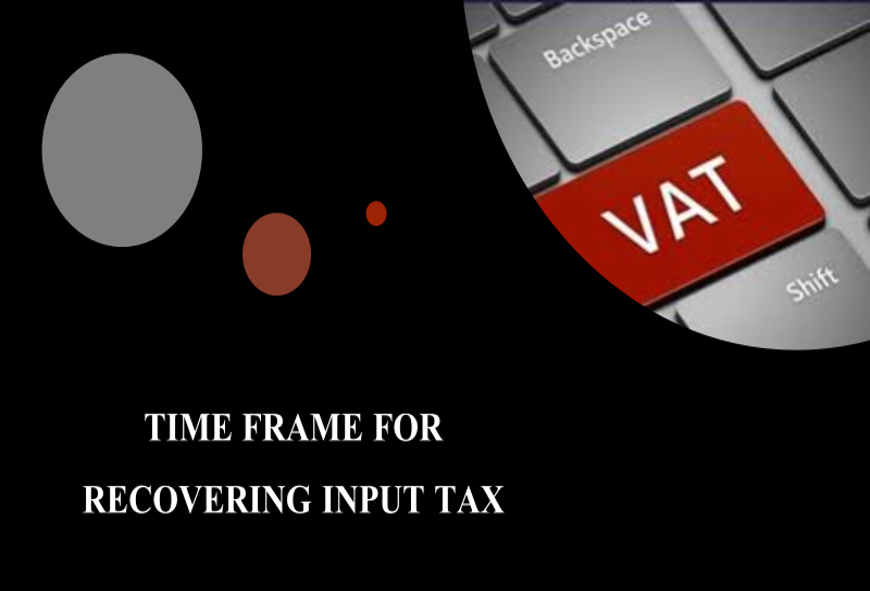“Time -frame for Recovering Input Tax”
By Rashid Ghulam Akbar,
Tax Director , ATH Business Consultants & Chartered Accountants
The Federal Tax Authority (FTA) in the UAE has issued a public clarification vide Number VAT017 discussing the time-frame for recovering the Input VAT by a taxable person.
The public clarification “Time – frame for recovering Input Tax” referred to as (“VATP017”) clarifies the FTA’s position relating to the interpretation of Article 55 of the Federal Decree-Law No. 8 of 2017 on Value Added Tax (“VAT Law”). The law prescribes the time-period within which input tax should be recovered by a taxable person.
This article explores in more detail the public clarification “VATP017” and aims to provide its reader with value-adding insight from a compliance perspective which will effectively optimize the process of recovering the input tax.
Two conditions to Recover Input Tax
In the normal course of business, recovering the correct input tax amount in compliance with “VATP017” is a practical challenge. Although, the public clarification “VATP017” provides a detailed overview of the factors to be considered before recovering input tax, however, many taxpayers are recovering the incorrect amount of input tax.
The two important conditions which must be satisfied to recover the input tax are:
- The tax invoice is received; and
- an intention to make the payment of consideration of the supply before the expiration of six months after the agreed date of payment is formed.
Tax Invoice Should be compliant to Recover Input Tax
The receipt of a tax invoice is not sufficient to meet the conditions to recover the input tax. The FTA has stated in the online virtual workshop for accredited tax agents, the invoice must be valid and retained.
The key point is the tax invoice must be valid in compliance with Article 59 of the Executive Regulation. If the tax invoice fails to meet all the particulars as per Article 59 of the Executive Regulation the tax invoice becomes invalid, therefore, it is not recoverable for input tax purposes.
Further, the valid tax invoice must be saved and must be retrievable for future reference.
Intention to Pay Criteria
The “intention to make the payment” can be established with the internal approval process but what will constitute an internal approval process is not clearly defined in the public clarification.
However, case studies presented in the online virtual workshop for accredited tax agents have illuminated what can potentially constitute an internal approval process.
- Input Tax Errors
Some of the errors related to recovering the input tax are as follows:
-
- Recovering input tax related to an invalid invoice/tax invoice;
- Recovering input tax without the intention of paying (Formal approval) ;
- Unpaid valid tax invoices are not adjusted after 6 months;
- Invalid Tax Invoice:
A taxpayer cannot claim input tax for an invalid tax invoice. Recovering such input tax will constitute VAT non-compliance, understate the output tax payable, and potentially attract fines/penalties from the FTA.
- Formal approval:
Failing to maintain adequate documentation to substantiate the intention to pay (Formal approval) will result in violating the condition of Article 55 of the Federal Decree-Law No. 8 of 2017 on Value Added Tax. Recovering input tax without an intention to pay will be considered VAT non-compliance, understate the output tax payable, and attract potential fines/penalties from the FTA.
- Unpaid Invoices:
Due to COVID 19, businesses are struggling to maintain a stable and optimal cash flow hence deferring payments to suppliers. The flip side of the non-payment to suppliers is businesses must repay input tax to the FTA which is recovered on valid tax invoices but the payment to the supplier remains outstanding 6 months after the due date.
- Compliance Focus
From a compliance perspective, the businesses must implement VAT Control procedures to achieve compliance with UAE VAT Law and such procedures can potentially mitigate the penalties from the FTA.
-
- Implementing a process to check the validity of the tax invoice;
- Evidence of receipt of the valid tax invoice;
- The valid tax invoices are saved in the Document Management system for future references;
- The formal approval procedure is documented and implemented to establish the “intention to pay”;
- Reviewing the creditor’s aging report to identify unpaid invoices on which the input tax is recovered and overdue by 6 months.
The above-mentioned points are not an exhaustive list for the VAT compliance, hence every taxpayer should look closely into their existing processes and update wherever required.
Conclusion (Key Takeaways)
To conclude, recovering the input tax from a compliance perspective is not as simple as it seems and has many challenges for the taxpayer. The taxpayers must ensure that only a valid tax invoice is recovered, else it can attract hefty penalties from the FTA.
It is highly recommended for the taxpayers to look at their existing process of checking the validity of the invoices, the establishment of intention to pay with adequate documentation, and keeping an eye on non-payment to suppliers for unpaid invoices to avoid any challenges during a tax audit.
- “Time -frame for Recovering Input Tax” - August 13, 2020


Stay connected